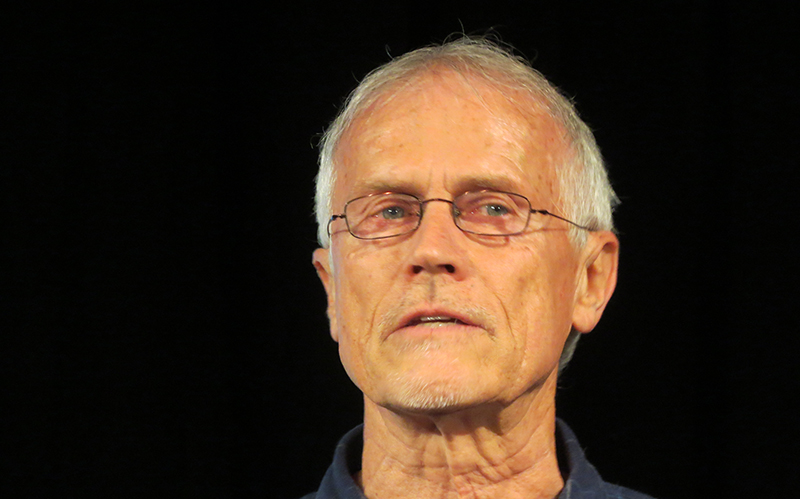Source: eyeonsunvalley.com
Published: July 11, 2016
STORY AND PHOTOS BY KAREN BOSSICK
Paul Hawken invoked Matt Damon—astronaut Matt Damon from “The Martian”–as he began the conversation on climate change.
“It’s space. It doesn’t cooperate,” he quoted The Martian. “I guarantee you that at some point, everything’s going to go south on you, and you’re going to say, ‘This is it. This is how I end.’”
Or, Hawken expanded on Damon’s trailer, “You can do the math. You can solve one problem, then do the next problem, then the next problem…”
|
|
Hawken and an army of experts from around the globe are doing the math. They will produce a book by the end of this year detailing the costs and benefits of the hundred best climate change solutions, ranging from light bulb technology encompassing smart glass to how educating teen-age girls might produce benefits.
Project Drawdown, as it’s called, would provide science-based data aimed at reducing CO2 and other greenhouse gases in the atmosphere in order to bring global temperatures down.
“The only goal that makes sense to us to to stop and turn around. We need a goal that empowers who we are as a people and expands and enlarges innovative thinking,” Hawken told those attending the second annual Sun Valley Forum on Resilience, which started Sunday at the nexStage Theatre in Ketchum.
The environmental entrepreneur said his team has been surprised by the top solutions that have emerged to date.
They include things you might expect like LED lighting, offshore wind turbines, reducing food waste, building solar farms, growing the fleet of electric vehicles, restoring farmland and eating a plant-based diet.
But they also include things like reducing methane emissions from growing rice, which provide a fifth of the calories the world eats.
Other top solutions that are emerging include establishing forests in areas where there was no forest, providing the world with clean cook stoves and tree intercropping. Also, carbon farming, enhancing peatland soils, tropical reforestation, agro forestry and regenerative agriculture.
“We’re so much in awe of what we don’t know about climate change,” Hawken said.
Hawken pointed to coming attractions fueled by innovation and technology: They include California-based Tri Alpha Energy’s bid to build a reactor that could generate vast amounts of clean power from fusion.
Graphene batteries are being built in Spain out of material that’s stronger than steel and thinner than a sheet of paper will endow electric cars, airplanes, computers and solar products with game-changing battery power that charges 10 times faster and stores 10 times more power.
There’s even work being done to repopulate the mammoth steppe—vast tracts of tundra and boreal forest in North America and Eurasia—with mammoths and other animals that can help regenerate the grasslands that insulate the tundra’s permafrost. Without the grasslands, the permafrost is melting, releasing greenhouse gases that have been trapped for hundreds of thousands of years.
“At some point we either say, ‘This is global warming. This is how it ends.’ Or we can go to work,” Hawken said.
The forum has brought in an impressive lineup of speakers to talk about on solutions and investing in projects that will address climate change, noted attendee Kiki Tidwell.
It resumes today with the first talk at 9 a.m. Day passes, which include breakfast and lunch, are available at the nexStage Theatre. (See www.sunvalleyinstitute.org for more information).
Ketchum Mayor Nina Jonas welcomed the group on Sunday, describing Ketchum’s efforts to reduce carbon emissions while bringing in jobs that have a low carbon footprint, such as a business dealing in green athletic wear.
Resilience is also about protecting what we have, she told the audience: “We’re a funky little town and we love that and want to do what we can to maintain that while allowing for change to preserve and enhance our economy.
Aimee Christensen, who co-founded the Sun Valley Institute which organized the forum, noted that Idaho’s capitol building is the only one heated by geothermal water, which is pumped 3,000 feet from underground. It has the largest wilderness area in the Lower 48 and the deepest gorge.
That said, the Gem State is falling behind other states in preparing for the increasing threats that will come with extreme heat, drought, wildfire, she said
Locally, one of the challenges is dealing with significant wealth inequality and a concentrated economy in which 70 percent of the economy relies on tourism. The forum, she said, is designed to find ways can survive, adapt, even thrive in the face of such challenges.
Locally, the Institute is taking advantage of Sun Valley’s sun, which is only 10 percent less than that in Texas, to Solarize Blaine. The program, which provides incentives to solarize homes and businesses, is the first such solar program in Idaho.
“Failure to address challenges is not an option,” she added.

